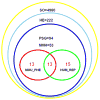Adaptive history of single copy genes highly expressed in the term human placenta
- PMID: 18848617
- PMCID: PMC2759754
- DOI: 10.1016/j.ygeno.2008.09.005
Adaptive history of single copy genes highly expressed in the term human placenta
Abstract
The chorioallantoic placenta is a shared derived feature of "placental" mammals essential for the success of eutherian reproduction. Identifying the genes involved in the emergence of the placenta may provide clues for understanding the biology of this organ. Here we identify among 4960 single copy genes in mammals, 222 that show high expression levels in human placentas at term. Further, we present evidence that 94 of these 222 genes evolved adaptively during human evolutionary history since the time of the last common ancestor of eutherian mammals. Remarkably, the majority of positive selection occurred on the eutherian stem lineage suggesting that ancient adaptations have been retained in the human placenta. Of these positively selected genes, 28 have been shown to play a role in human pregnancy and placental biology, and at least 26 have important pregnancy-related phenotypes in mice. Adaptations in genes highly expressed in human placenta are attractive candidates for functional and clinical studies.
Figures



Similar articles
-
Elephant transcriptome provides insights into the evolution of eutherian placentation.Genome Biol Evol. 2012;4(5):713-25. doi: 10.1093/gbe/evs045. Epub 2012 Apr 30. Genome Biol Evol. 2012. PMID: 22546564 Free PMC article.
-
Adaptive changes in the transcription factor HoxA-11 are essential for the evolution of pregnancy in mammals.Proc Natl Acad Sci U S A. 2008 Sep 30;105(39):14928-33. doi: 10.1073/pnas.0802355105. Epub 2008 Sep 22. Proc Natl Acad Sci U S A. 2008. PMID: 18809929 Free PMC article.
-
Genetic recapitulation of human pre-eclampsia risk during convergent evolution of reduced placental invasiveness in eutherian mammals.Philos Trans R Soc Lond B Biol Sci. 2015 Mar 5;370(1663):20140069. doi: 10.1098/rstb.2014.0069. Philos Trans R Soc Lond B Biol Sci. 2015. PMID: 25602073 Free PMC article.
-
Evolution of the placenta during the early radiation of placental mammals.Comp Biochem Physiol A Mol Integr Physiol. 2007 Dec;148(4):769-79. doi: 10.1016/j.cbpa.2007.01.029. Epub 2007 Feb 2. Comp Biochem Physiol A Mol Integr Physiol. 2007. PMID: 17347003 Review.
-
Progressive Exaptation of Endogenous Retroviruses in Placental Evolution in Cattle.Biomolecules. 2023 Nov 21;13(12):1680. doi: 10.3390/biom13121680. Biomolecules. 2023. PMID: 38136553 Free PMC article. Review.
Cited by
-
The Genomes of the Livebearing Fish Species Poeciliopsis retropinna and Poeciliopsis turrubarensis Reflect Their Different Reproductive Strategies.Mol Biol Evol. 2020 May 1;37(5):1376-1386. doi: 10.1093/molbev/msaa011. Mol Biol Evol. 2020. PMID: 31960923 Free PMC article.
-
Review: Toward an integrated evolutionary understanding of the mammalian placenta.Placenta. 2011 Mar;32 Suppl 2(Suppl 2):S142-5. doi: 10.1016/j.placenta.2011.01.005. Placenta. 2011. PMID: 21306776 Free PMC article. Review.
-
Placental origins of adverse pregnancy outcomes: potential molecular targets: an Executive Workshop Summary of the Eunice Kennedy Shriver National Institute of Child Health and Human Development.Am J Obstet Gynecol. 2016 Jul;215(1 Suppl):S1-S46. doi: 10.1016/j.ajog.2016.03.001. Epub 2016 Mar 10. Am J Obstet Gynecol. 2016. PMID: 26972897 Free PMC article.
-
Endogenous retroviruses function as species-specific enhancer elements in the placenta.Nat Genet. 2013 Mar;45(3):325-9. doi: 10.1038/ng.2553. Epub 2013 Feb 10. Nat Genet. 2013. PMID: 23396136 Free PMC article.
-
Rat placentation: an experimental model for investigating the hemochorial maternal-fetal interface.Placenta. 2012 Apr;33(4):233-43. doi: 10.1016/j.placenta.2011.11.026. Epub 2012 Jan 28. Placenta. 2012. PMID: 22284666 Free PMC article. Review.
References
-
- Luckett WP. Comparative development and evolution of the placenta in primates. In: Luckett WP, editor. Reproductive Biology of the Primates. S. Karger; New York: 1974. pp. 142–234. - PubMed
-
- Benirschke K, Kaufmann P. Pathology of the human placenta. Spinger; New York: 2000.
-
- Mossman HW. Vertebrate Fetal Membranes. Rutgers University Press; New Brunswick: 1987.
-
- Wells M. The pathology of gestational trophoblastic disease: recent advances. Pathology. 2007;39:88–96. - PubMed
Publication types
MeSH terms
Grants and funding
LinkOut - more resources
Full Text Sources

